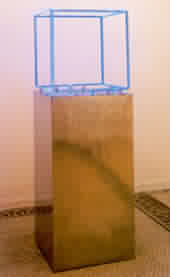Stephen Antonakos emigrated with his family from Greece to the United States in 1930, when he was four years old. He grew up in Brooklyn as the youngest of five children, went to Greek school, and became an altar boy.
Antonakos learned to draw by watching an older brother draw. After high school, he worked briefly as a free-lance illustrator, "but my visual education," he remarks, "was really begun and developed at the Museum of Modern Art". He started making constructions of scraps of fur and fabric that he found in the fur district, where he had a studio, and by the late 1950s, his collages were being exhibited.
Antonakos has written of this time that he "often worked with open and closed boxes, deep frames, other kinds of enclosures that functioned for me like tiny rooms, containers of feelings. Collecting, making, and placing elements in new enclosures made them more concentrated, more intense: He traces this need back to the very small church in Agios Nikolaos, "the village where I was born. Our houses were very simple and people worked very hard. But to enter the chapel was to enter another world. Being inside it was like being plunged deep inside my own feelings, and finding a paradise at the same time. The rich colors, the gold, the heightened atmosphere, all moved me immensely. I felt more myself there than anywhere else".
During the 1960s, annotates began sculpting in neon and thinking in terms of architecture-making his neon tubes cross corners, define a ceiling area, bisect rooms, move onto the exteriors of buildings. Since then, he has executed more than thirty-five permanent public installations in the United States, Japan, and Europe, not including the "chapels" he has created for many important museums.
"Neon is a controlled paradise;" Antonakos has remarked, but cautions that his work, particularly the "chapels" must not be over-identified with Greek Orthodoxy "it is meant to address everyone."

